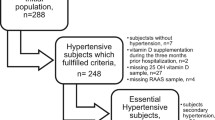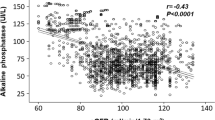Abstract
The aim of this study was to compare zinc (Zn) metabolism parameters in groups of premenopausal and postmenopausal women with moderate and severe primary arterial hypertension. The study included 38 women, of which 15 were premenopausal and 23 were postmenopausal. Postmenopausal women had a positive correlation between total (ERCt-Zn) and oubain-dependent (ERCos-Zn) rate constants of Zn efflux from lymphocyte (k = 0.52). In premenopausal women’s ERCos-Zn was negatively but weakly correlated with serum Zn (Zn-s) (k = 0.35). The Zn ERCt-Zn and ERCos-Zn did not show any correlation with age, as did Zn-s. Lymphocyte Zn correlated negatively with age only in premenopausal women (k = -0.62).
The renin-angiotensin-aldosterone system correlated with Zn metabolism parameters. In premenopausal women, plasma renin activity and serum aldosterone showed positive correlations with lymphocyte Zn (Zn-l) (k = 0.63 andk = 0.41, respectively), and in postmenopausal women, it correlated negatively with Zn-s (k = -0.38) and whole aldosterone correlated negatively with ERCos-Zn (k = -0.41).
Positive correlations between Zn metabolism parameters and arterial blood pressure in premenopausal women were as follows: ERCt-Zn with diastolic blood pressure (dRR) (k = 0.40) and ERCos-Zn with dRR (k = 0.47). In postmenopausal women, the correlations between ERC-t-Zn and dRR and systolic blood pressure (sRR) were negative (k = -0.53 andk = -0.63, respectively). A similar situation was observed between dRR and sRR and Zn-s (k = -0.40 andk = -0.38, respectively). The body mass index (BMI) was positively correlated with ERCt-Zn in premenopausal women (k = 0.36), whereas in postmenopausal, it was negatively correlated with ERCos-Zn (k = -0.42). For the whole group, negative correlations were seen between ZnS and dRR and sRR (k = -0.36 andk = -0.39, respectively) and between ERCos-Zn and BMI (k = -0.39). The results presented show differences in Zn metabolism in arterial hypertension between premenopausal and post-menopausal women. The role of estrogens in these differences is disscused.
Similar content being viewed by others
References
N. Kaplan,Clinical Hypertension, 6th ed., William & Wilkins, Baltimore, pp. 97-98 (1994).
S. Tubek, Gender differences in selected zinc metabolism parameters in patients with mild primary arterial hypertension,Biol. Trace Element Res. 114, 55–64 (2006).
E. D. Thompson, P. E. Olsson, G. D. Mayer, P. J. Walsh, E. Burge, and C. Hogstrand, Effects of 17 beta-estradiol on levels and distribution of metallothionein and zinc in squirrelfish,Am. J. Physiol. Regul. Integr. Comp. Physiol. 280, R527-R535 (2001).
M. E. Wastney, S. Ahmed, and R. I. Henkin, Changes in regulation of human zinc metabolism with age,Am. J. Physiol.,263(5 Pt. 2), R1162-R1168 (1992).
P. Darlu, J. M. Lalouel, J. G. Henrotte, and D. C. Rao, A genetic study of red blood zinc concentration in man,Hum. Heredity 33, 311–320 (1983).
R. D. Lindeman, M. L. Clark, and J. P. Colmore, Influence of age and sex on plasma and red-cell zinc concentration,J. Gerontol. 26, 358–363 (1971).
S. Tubek, The zinc content in lymphocytes and the activity of zinc ions efflux from lymphocytes in primary arterial hypertension,Biol. Trace Element Res. 107, 89–99 (2005).
M. G. Matera, D. De Santis, S. Maione, et al., Antihypertensive drugs and urinary excretion of zinc in genetically hypertensive rats,Curr. Ther. Res. 46, 667–680 (1989).
G. Vivoli, M. Bergomi, S. Rovesti, M. Pinotti, and E. Caselgrandi, Zinc, copper and zinc- or copper-dependent enzymes in human hypertension,Biol. Trace. Element Res. 49, 97–106 (1995).
G. J. L. Zozaya, M. P. Viluria, and A. Castro, Urinary excretion of zinc in patients with essential arterial hypertension,Res. Commun. Chem. Pathol. Pharmacol. 48, 445–453 (1985).
M. D. Chen, P. Y. Lin, C. T. Tsou, J. J. Wang, and W. H. Lin, Selected metals status in patients with nonisulin-dependent diabetes mellitus,Biol. Trace Element Res. 50, 119–124 (1995).
W. B. Kinlaw, A. S. Levine, and J. E. Morley, Abnormal zinc metabolism in type II diabetes mellitus,Am. J. Med. 75, 273–280 (1983).
N. Ddo Marreiro, M. Fisberg, and S. M. Cozzolino, Zinc nuritional status in obese children and adolescents,Biol. Trace Element Res. 86, 107–122 (2002).
N. Ddo Marreiro, M. Fisberg, and S. M. Cozzolino, Zinc nuritional status and its relationship with hyperinsulinemia in obese children and adolescents,Biol. Trace Element Res. 100, 137–149 (2004).
A. Boyum, Isolation of mononuclear cells and granulocytes from blood. II. Isolation of mononuclear cells by centrifugation and of granulocytes by combining centrifugation and sendimentation of 1 g,Scand. J. Clin. Lab. Invest. 21(Suppl. 97), 77–85 (1968).
A. Noworolska, Antygeny onkopłodowe w komórkach szeregu mielocytarnego, Praca doktorska. AM Wrocław (1984).
A. M. Heagerty, R. F. Bing, M. Miluer, H. Thuston, and J. W. Shales, Leucocyte membrane sodium transport in normotensive populations; dissociation of abnormalities of sodium efflux from raised blood pressure,Lancet 2, 894–905, (1982).
Perkin-Elmer,Analytical Methods for Atomic Absorption Spectrometry, Perkin-Elmer, Norwalk, CT (1971).
A. J. Turner, C. D. Brown, J. A. Carson, and K. Barens, The neprilysin family in health and disease,Adv. Exp. Med. Biol. 477, 229–240 (2000).
W. R. Harlan, J. R. Landis, R. L. Schmouder, N. G. Goldstein, and L. C. Harlan, Blood lead and blood pressure. Relationship in the adolescent and adult US population,JAMA 253, 530–534 (1985).
B. Hennig, Y. Wang, S. Ramasamy, and C. J. McClain, Zinc deficiency alters barrier function of cultured porcine endothelial cells,J. Nutr. 122, 1242–1247 (1992).
B. Hennig, Y. Wang, S. Ramasamy, and C. J. McClain, Zinc protects against tumor necrosis factor-induced disruption of porcine endothelial cell monolayer inegrity,J. Nutr. 123, 1003–1009 (1993).
S. Tubek, The zinc content in lymphocytes and the activity of zinc ions efflux from lymphocytes in primary arterial hypertension,Biol. Trace Element Res. 107, 89–99 (2005).
Author information
Authors and Affiliations
Rights and permissions
About this article
Cite this article
Tubek, S. Selected zinc metabolism parameters in premenopausal and postmenopausal women with moderate and severe primary arterial hypertension. Biol Trace Elem Res 116, 249–255 (2007). https://doi.org/10.1007/BF02698009
Received:
Accepted:
Issue Date:
DOI: https://doi.org/10.1007/BF02698009




